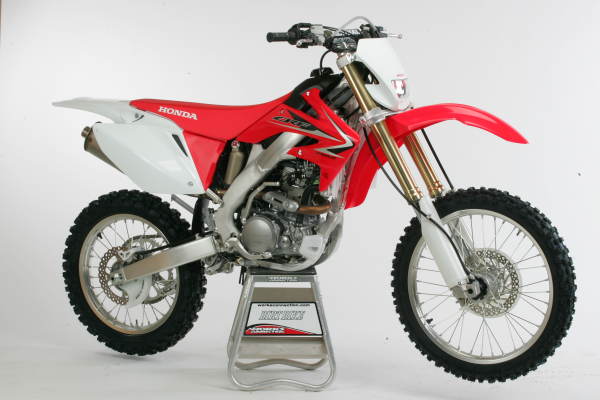The XR reborn

The X’s fork and shock have some teeth. Don’t automatically go to the revalving man until you ride it for yourself.
It ís sad when a cult is left without a leader. That’s what happened back in 2005 when the XR250R disappeared. Only now, after four years of mourning, are the faithful ready to move on and deal with the fact that the XR won’t be coming back. The CRF250X has finally been accepted as America’s official small-bore trail bike. It didn’t happen quickly or easily, but it happened.
The resistance came from hard-core XR250 fans; guys like Chris Smith who raced the little stone axe of a bike all over the world. He and others didn’t understand why Honda would discontinue a torquey, simple, mild trail bike with something based on a high-rev motocrosser. But now that the loss anxiety has faded, those riders have taken a second look at the X and have realized that even though it’s not an XR, it’s still pretty darn good.
THE JOURNEY FROM MOTOLAND

When trails get ugly, tight and delightfully nasty, you’re in CRF250X country.
Our 2009 test bike is a California model. Of all the dirt bikes in Honda’s line, the 250X is the only one that has a split identity; there’s a version for 49 states and a version for La-La land. The only difference is the cam, which results in slightly more torque for the California model. Weird. In either case, the bike makes spectacular bottom-end power for its breed. Face it, a 250 four-stroke isn’t supposed to have torque. That was what lifted the old XR to its icon status. It ran great down low. Of course, it was a dog up higher, but that’s forgotten and forgiven. The CRF250X has near-XR levels of power on the bottom, but you would never know because the motor feels so different. With the CRF, the bottom-end is like fly-over country–something you go through on the way to somewhere else.

Honda designed the X motor to work perfectly well in stock form. If you want more power, you’ll have to work for it.
Conversely, if you decide to take the X racing, you’ll need to find more power, and it isn’t easy. A race pipe doesn’t produce a very satisfying increase by itself. You have to go all the way, with a different cam and piston to really made a difference. And then you [will] have to mess with jetting and airbox changes. There’s no shortcut here.
BUT LEAVE THE CHASSIS BE
If you spent your whole budget finding more power and decided to drop the CRF250X into a national enduro, you would be fine. You wouldn’t have to do a thing to the chassis. It doesn’t need suspension work. It doesn’t need a steering damper. It doesn’t even need to lose weight. The Honda handles great. It feels light and easy to dominate, and generally encourages you to go faster and faster. The little CRF has Honda’s off-road version of the HPSD system, which is a tiny shock-absorber-like steering damper mounted behind the headlight. It is the least intrusive damper in the universe, so much so that many desert racers mount [another] steering damper on the bars (mostly on the 450 version). You wouldn’t double-down dampers on a 250 four-stroke, of course, because there probably isn’t much high-speed desert on your agenda. In fact, the HPSD system is just right for the 250; you don’t feel it unless you remove it. Then the bike loses some of the magic stability in fast turns.
Likewise, the suspension is perfect for the 250’s target riding. It’s cushy and comfy enough over the little stuff, but someone at Honda definitely spiked the punch. You can push the CRF as hard as you want on trails, and you never feel like you’re over-riding the fork and shock. It can even deal with whoops the size of dead horses without issue. Only when you get cocky and take it on a motocross course does the bike reach its limits. The X is set up much more aggressively than anything you might expect out of a 250 four-stroke.
That’s why the bike is developing it own secret society. Yeah, those who bemoan the loss of the XR still exist, but they’ll come around. In stock form, the 2009 Honda CRF250X is the best 250cc trail bike that we’ve ever had. It’s about time that we made it official.
Once upon a time, there was a bike called the XR250R with a cult of crazy followers. The CRF is a worthy replacement. The suggested retail price is the only change for 2009; it’s $6699.





Comments are closed.